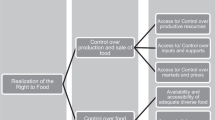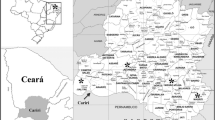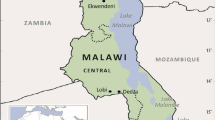Abstract
Poverty, food security, and sustainability are intimately intertwined, driving conflict and synergy between environmental and societal concerns. Brazil’s flagship food security policies were implemented over a decade ago to address these issues simultaneously. Global institutions have pledged over 2 million US$ to develop similar programs in sub-Saharan Africa, yet empirical assessments of many aspects of these policies are still lacking. We focus on a case study in the state of Minas Gerais and assess the agricultural and environmental impacts of the Purchase with Simultaneous Donation (PSD) program. The PSD provides stable markets as incentives to diversify production, but we find no effect of participation on changes in local agricultural practices, production or income. While some farms are expanding, regional agricultural production appears to be declining due to local economic development and related shortages in farm labor. The PSD’s limited impact arises because most farmers only participate irregularly, typically during the dry season when the program offers higher prices than the local market price. Furthermore, participation is constrained by the specific nature of PSD contracts and centralized governance of the program. We complement these findings with data from the Brazilian Ministry of Social Development and the 2006 agricultural census, which show substantial variation in the availability of PSD initiatives, and the funding allocated to them at local, regional and national levels. We suggest that adaptive management strategies that can respond to local market conditions could lead to more equitable and efficient food security and agricultural policies in Brazil and elsewhere.



Similar content being viewed by others
References
Abson, D. J., Fraser, E. D. G., & Benton, T. (2013). Landscape diversity and the resilience of agricultural returns: a portfolio analysis of land-use patterns and economic returns from lowland agriculture. Agriculture and Food Security, 2, 2.
Angelsen, A. (2010). Policies for reduced deforestation and their impact on agricultural production. Proceedings of the National Academy of Sciences of the USA, 107(46), 19639–19644.
Angelsen, A., & Kaimowitz, D. (2001). Agricultural technologies and tropical deforestation (Angelsen, A). Wallingford: CABI Publishing.
Araghi, F. A. (1995). Global depeasantization, 1945–1990. The Sociological Quarterly, 36(2), 337–368.
Araghi, F. (2008). The invisible hand and the visible foot: peasants, dispossession and globalization. In A. H. Akram-Lodhi & C. Kay (Eds.), Peasants and globalisation: political economy, rural transformation and the agrarian question (pp. 111–147). London: Routledge.
Araújo, C. A., & Alessio, M. F. (2005) Política municipal de abastecimento e segurança alimentar. Fundação Getulio Vargas, Escola de Administração de Empresas de São Paulo, Belo Horizonte, Brazil.
Barros, F. C., Matijasevich, A., Harris Requejo, J., Giugliani, E., Gorreti Maranhão, A., Monteiro, C. A., et al. (2010). Recent trends in maternal, newborn, and child health in Brazil: progress toward millennium development goals 4 and 5. American Journal of Public Health, 100(10), 1877–1889.
Benjamini, Y., & Hochberg, Y. (1995). Controlling the false discovery rate: a practical and powerful approach to multiple testing. Journal of the Royal Statistical Society, Series B (Statistical Methodology), 57(1), 289–300.
Bryceson, D. F. (2002). The scramble in Africa: reorienting rural livelihoods. World Development, 30(5), 725–739.
Camara, G., Souza, R. C. M., Freitas, U. M., & Garrido, J. (1996). SPRING: Integrating remote sensing and GIS by object-oriented data modelling. Computers & Graphics, 20(3), 395–403.
Chappell, M. J. (2009) From food security to farm to formicidae: Belo Horizonte, Brazil’s Secretaria Municipal de Abastecimento and biodiversity in the fragmented Atlantic Forest. PhD Thesis. The University of Michigan.
Chavas, J. P., & Di Falco, S. (2012). On the role of risk versus economies of scope in farm diversification with an application to Ethiopian farms. Journal of Agricultural Economics, 63(1), 25–55.
Chmielewska, D., & Souza, D. (2010). The food security context in Brazil. International Policy Centre for Inclusive Growth. Brasilia: United Nations Development Programme.
DeFries, R. S., Rudel, T. K., Uriarte, M., & Hansen, M. (2010). Deforestation driven by urban population growth and agricultural trade in the twenty-first century. Nature Geoscience, 3, 178–181.
Development Core Team, R. (2011). R: a language environment for statistical computing. Vienna: R Foundation for Statistical Computing.
Dimitri, C., Effland, A., & Conklin, N. (2005). The 20th century transition of U.S. agriculture and farm policy. Washington, D. C: Economic Information Bulletin No. 3, U.S. Department of Agriculture, Economic Research Service.
Doretto, M., & Michellon, E. (2007). Avaliação dos impactos econômicos, sociais e culturais do programa de aquisição de alimentos no Paraná. Sociedade e Desenvolvimento Rural, 1, 107–138.
Dorward, A. R., Fan, S., Kydd, J., Lofgren, H., Morrison, J., Poulton, C., et al. (2004). Institutions and policies for pro-poor agricultural growth. Development Policy Review, 22(6), 611–622.
Dorward, A. R., Kirsten, J. F., Omamo, S. W., Poulton, C., & Vink, N. (2009). Institutions and the agricultural development challenge in Africa. In J. F. Kirsten, A. R. Dorward, C. Poulton, & N. Vink (Eds.), Institutional economics perspective on African agricultural development. Washington DC: IFPRI.
Fenwick, T. B. (2009). Avoiding Governors: the success of Bolsa Família. Latin American Research Review, 44(1), 102–131.
Food and Agriculture Organization of the United Nations (FAO) (2012) Brazil to fund food purchasing program in five African countries. FAO Media Centre. Available: http://www.fao.org/news/story/en/item/123551/icode/. Accessed 10 May 2013.
García-Barrios, R., & García-Barrios, L. E. (1990). Environmental and technological degradation in peasant agriculture: a consequence of development in Mexico. World Development, 18(11), 1569–1585.
Godfray, H. C. J., Beddington, J. R., Crute, I. R., Haddad, L., Lawrence, D., Muir, J., et al. (2010). Food security: the challenge of feeding 9 billion people. Science, 327, 812–818.
Instituto Brasileiro de Geografia e Estatística (IBGE) (2013) Available: http://www.ibge.gov.br/estadosat/temas.php?sigla=mg&tema=resultgeramostra_censo2010. Accessed July 21st, 2013.
Instituto Brasileiro de Geografia e Estatística (IBGE) (2014a) http://www.sidra.ibge.gov.br. Accessed October 16, 2014.
Instituto Brasileiro de Geografia e Estatística (IBGE) (2014b) Available: http://aplicacoes.mds.gov.br/sagi/paa/visi_paa_geral/pg_principal.php?url=abertura. Accessed October 16, 2014.
Instituto Nacional de Pesquisas Espaciais (INPE). (2012) SOS Mata Atlântica: Atlas da Mata Atlântica: Available: http://mapas.sosma.org.br. Accessed 17 March 2014.
International Assessment of Agricultural Knowledge Science and Technology for Development (IAASTD). (2009). Agriculture at a crossroads: International assessment of agricultural knowledge, science and technology for development. Washington, D.C.: Island Press.
International Food Policy Research Institute (IFPRI). (2005). The future of small farms: Proceedings of a research workshop, Wye, UK, June 26–29, 2005. Washington, DC: International Food Policy Research Institute (IFPRI).
Lin, B. B., Chappell, M. J., Vandermeer, J., Smith, G., Quintero, E., Bezner-Kerr, R., et al. (2011). Effects of industrial agriculture on global warming and the mitigation potential of small-scale agro-ecological farms. CAB Reviews: Perspectives in Agriculture, Veterinary Science, Nutrition, and Natural Resources, 6(20), 1–18.
Mattei, L. (2007). Políticas públicas de combate à fome: O caso do programa de aquisição de alimentos da agricultura familiar no estado de Santa Catarina. Sociedade e Desenvolvimento Rural, 1, 1–31.
Ministerio do Desenvolvimento Social e Combate a Fome (MDS) (2013) PAA Data; Janeiro a Março do 2013. Available: http://aplicacoes.mds.gov.br/sagi/paa/2013/visi_paa_geral/pg_principal.php?url=abertura. Accessed 19 July 2013.
Ministerio do Desenvolvimento Social e Combate a Fome (MDS) (2014) PAA Data http://aplicacoes.mds.gov.br/sagi-data/misocial/tabelas/mi_social.php. Accessed 16 October 2014
Moran, S. (2011). Brazilian bill weakens Amazon protection. Nature. doi:10.1038/nature.2011.9584.
Moreira, C., Piccin, M., Santarelli, M., & Gadelha, E. (2010). O programa de aquisição de alimentos da agricultura familiar e o Fome Zero. In A. V. Aranha (Ed.), Fome Zero: Uma história brasileira. Ministério do Desenvolvimento Social e Combate à Fome (pp. 206–218). Brasília: MDS.
Myers, N., Mittermeier, R. A., Mittermeier, C. G., da Fonseca, G. A. B., & Kent, J. (2000). Biodiversity hotspots for the conservation of nature. Nature, 403, 853–858.
Paganini, S. (2010). A implantação do PAA - Programa de Aquisição de Alimentos. In A. V. Aranha (Ed.), Fome Zero: Uma história brasileira. Ministério do Desenvolvimento Social e Combate à Fome (pp. 105–205). Brasília: MDS.
Páres-Ramos, I. K., Gould, W. A., & Aide, T. M. (2008). Agricultural abandonment, suburban growth, and forest expansion in Puerto Rico between 1991 and 2000. Ecology and Society, 13, 1.
Perfecto, I., & Vandermeer, J. (2010). The agroecological matrix as alternative to the land-sparing/agriculture intensification model. Proceedings of the National Academy of Sciences of the USA, 107(13), 5786–5791.
Perfecto, I., Vandermeer, J., & Wright, A. (2009). Nature’s matrix: Biodiversity, agriculture and food sovereignty. London: Earthscan.
Phalan, B., Balmford, A., Green, R. E., & Scharlemann, J. P. W. R. (2011). Minimising the harm to biodiversity of producing more food globally. Food Policy, 36, S62–S71.
Ravallion, M., Chen, S., & Sangraula, P. (2007). New evidence on the urbanization of global poverty: Background paper for the world development report 2008. Washington, D.C.: The World Bank.
Rudel, T. K., Bates, D., & Machinguiachi, R. (2002). A tropical forest transition? Agricultural change, out-migration, and secondary forests in the Ecuadorian Amazon. Annals of the Association of American Geographers, 92(1), 87–102.
Rudel, T. K., DeFries, R., Asner, G. P., & Laurance, W. F. (2009). Changing drivers of deforestation and new opportunities for conservation. Conservation Biology, 23(6), 1596–1405.
Sloan, S. (2007). Fewer people may not mean more forest for Latin American forest frontiers. Biotropica, 39(4), 443–446.
Taylor, M. T. (2009). Institutional development through policy making: a case study of the Brazilian Central Bank. World Politics, 61(3), 487–515.
Tollefson, J. (2012). President prunes forest reforms. Nature, 486, 13.
Tscharntke, T., Klein, A. M., Kruess, A., Steffan-Dewenter, I., & Thies, C. (2005). Landscape perspectives on agricultural intensification and biodiversity-ecosystem service management. Ecology Letters, 8, 857–874.
Tscharntke, T., Clough, Y., Wanger, T. C., Jackson, L., Motzke, I., Perfecto, I., et al. (2012). Global food security, biodiversity conservation and the future of agricultural intensification. Biological Conservation, 151(1), 53–59.
Acknowledgments
We thank Belo Horizonte’s Secretariat for Food Security for their logistical support as well as the staff of the EMATER and farmers’ union offices in Mário Campos who were instrumental in setting up initial contacts with the municipality’s farming community. We remain indebted to all the participants for their time and willingness to take part in the study. We also thank David Abson, Joern Fischer, Lorenza B. Fontana, Brenda B. Lin and two anonymous reviewers for useful comments on previous versions of this manuscript. This research was funded through a Washington State University grant to MJC.
Author information
Authors and Affiliations
Corresponding author
Electronic supplementary material
Below is the link to the electronic supplementary material.
Supplementary Figure 1
Proportion of farming establishments within different land holding size categories in states with active PSD programs engaging with individual farmers. Like in several other states, the majority of farmers in Minas Gerais operate lands smaller than 20 ha in size. Data are based on the 2006 Brazilian agricultural census (IBGE 2014a). (TIFF 76676 kb)
Supplementary Figure 2
Proportion of the farming establishment engaging in different farming activities in states with active PSD programs that include individual farmers. In most states, including Minas Gerais, the majority of farmers engage in livestock production with little horticulture and varying degrees of temporary and permanent cash crop production. Data are based on the 2006 Brazilian agricultural census (IBGE 2014a). (TIFF 76475 kb)
Supplementary Figure 3
Proportion of agricultural land managed by different income categories in states with active PSD programs engaging with individual farmers. In most states, including Minas Gerais, states, the majority of land is managed by farmers earning less than R$10,500 per month. Data are based on the 2006 Brazilian agricultural census (IBGE 2014a). (TIFF 76826 kb)
Rights and permissions
About this article
Cite this article
Oldekop, J.A., Chappell, M.J., Peixoto, F.E.B. et al. Linking Brazil’s food security policies to agricultural change. Food Sec. 7, 779–793 (2015). https://doi.org/10.1007/s12571-015-0475-4
Received:
Accepted:
Published:
Issue Date:
DOI: https://doi.org/10.1007/s12571-015-0475-4




